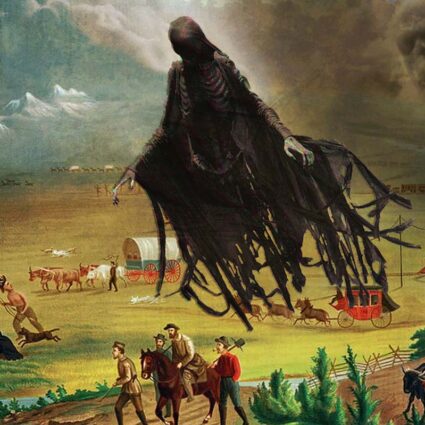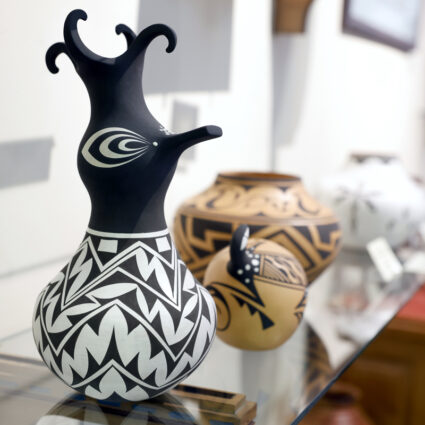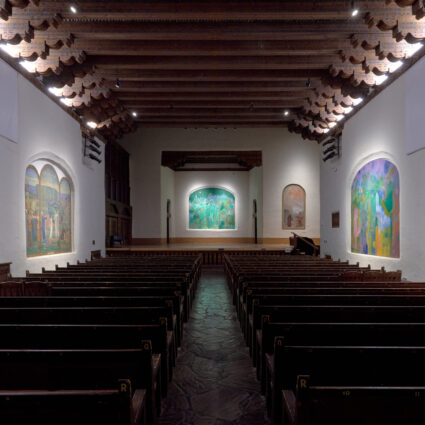1
It’s like the suburbs, she said. In the ’50s, I said.
I was on a tour of the Manhattan Project National Historic Park in Los Alamos, NM, with my partner this April, in the shadow of the Starbucks that seems to serve as the town’s hub. It took us almost an hour to realize why it felt so weird up there. Los Alamos is nothing like the rest of Northern New Mexico: Northern New Mexico’s people, culture, and plant life were categorically removed from the plateau to make room for the Manhattan Project in the early 1940s. Eliza Naranjo Morse, an artist from Santa Clara Pueblo, remembers riding up the Hill with her family as a kid to eat at restaurants. This would have been the 1980s and ’90s. The town felt out of place from the rest of the valley, she told me, “like a different country”—everyone was white; there were expanses of green grass, a pond. It was like stepping out of the car in “Ohio or something.”
Los Alamos is 86 percent white, according to the 2010 US Census. The valley that surrounds it is 87 percent Hispanic or Latinx, 85 percent Native American in the nearby pueblos. The median household income on the Hill $98.5k, vs. $30k in the valley. Each day Morse, who grew up and later returned to pueblo land in Española, feels the visual impact of the stream of cars headed up the Hill in the morning, back down in the late afternoon. Her mom described to her a similar caravan from the Hill years before, wagons that came down into the pueblo and began collecting men from the fields to go “up there” and work. Many of these workers provided construction, cleaning, and maintenance services on the Hill: things like mopping radioactive spaces, pouring the mop water out. And where else would it flow but into the canyons, the water source for the surrounding pueblos and towns, spiritually and materially precious to the people in the valley. That downward flow, Morse said, is one of the things she thinks of when she looks in the direction of the Hill.
In schools in the valley, the Los Alamos National Laboratories (LANL) was a sign of possibility and success. Work hard and you can become an engineer, students were told. An engineer of what was not explained. Most of art writer Alicia Inez Guzmán’s family and community in Truchas, a town across the canyon from Los Alamos, relied and continue to rely on LANL for their income. In her early twenties, Guzmán herself worked at one of the LANL Area sites, and later at the Bradbury Science Museum, but never felt like she belonged on the Hill. She told me, “There’s a palpable sense of un-belonging in the town (even down to urban design) that I think people from surrounding communities feel.”
The entrance is no longer gated, but the town doesn’t feel especially open to others. Fences and warning signs cordon off much of the land.
Those who live near Los Alamos feel its visual impact on the landscape. It sits on the plateau above them. The entrance is no longer gated, but the town doesn’t feel especially open to others. Fences and warning signs cordon off much of the land. “The whole area is so militarized that, both visibly and psychologically, you feel like you’re in some alternate reality,” Guzmán said. The Lab continues to employ and to contaminate the surrounding communities in the valley, and it exports some of its contamination further south, to the Waste Isolation Pilot Plant (WIPP) in southeastern New Mexico. Guzmán explained, “It’s hard to say where the effects begin and end, because the Lab is a fact of northern New Mexico now.” The workers from Española and the surrounding pueblos who were first brought to the Hill to work service jobs, without proper respiratory or skin protection from radiation, now suffer a cancer rate “by some estimations… at seven times the national average,” according to writer Darryl Lorenzo Washington.(1) Guzmán calls it an example of “extreme environmental racism.” When I ask what kind of commemoration she would like to see to the Manhattan Project at Los Alamos, she says, “I’d like to see an honest monument.”
2
At the Los Alamos History Museum, you can buy neon hats with radioactive warning labels on them, photo postcards of the Trinity Test mushroom cloud, pins in the shape of both original nuclear bombs. The museum attendant assured me, as I handed over my five dollars for admission, that they used to have missile earrings too; they were super popular. Now the only earrings I see are in the shapes of paper cranes for Hiroshima.
The National Park Service—the same group known for their rogue Twitter accounts voicing resistance to the Trump administration this year—is tasked with interpretation for the new Manhattan Project National Historic Park consisting of three sites: Los Alamos, NM, Hanford, WA, and Oak Ridge, TN. The historicization of these sites, passed by Congress and signed by President Obama in 2014, implies a relegation of the nuclear project to history. The Cold War ended: the age of the bomb is no longer our present. When I asked an NPS representative what it means to make “historic” a site that is still active, still crucial to the project of US nuclear weapons stewardship, I was told the park intends only to address the stories and sites of 1943-1945, the years of the Manhattan Project, in the context of that time. It is not engaged with the present. At the small NPS visitors center for the Los Alamos site, the first thing I saw was a table covered in laminated newspaper clippings and print-outs about the Lab, its work, and its effects, some dated as recently as March 2017. This was neither the first nor the last wave of cognitive dissonance I felt as I walked the park.
The current iteration of the Manhattan Project National Historic Park site at Los Alamos is a walking tour through and around several preserved buildings, most of which served as housing for scientists, and it includes two museums: the Los Alamos History Museum and the Bradbury Science Museum. The reverse side of the park map indicates a set of sites which are not currently open to the public, including some of the historic labs and weapons testing facilities. These, I was told, will be accessible by reservation-only bus tour at some point in the next two to five years. The National Park Service assured me that the Department of Energy, which owns the land, has plenty of “protocol” to ensure the safety of these sites. They have been “stabilized and preserved.” Creating a park open to the public at an active weapons facility that maintains high levels of security and secrecy is no simple task. I can’t help but wonder why they did it.
As I walked the tour route, I became increasingly paranoid. My partner admired the plants and trees. “Radioactive plants,” I said. “Radioactive trees. Radioactive water. Radioactive air.” The invisibility of the Lab’s effects makes it all the more sinister, yet even easier to ignore. Invisible, of course, for people other than those immediately affected. And even among downwinders, the cancers, the ailments, and the disabilities often occur two generations down the line from the contamination itself.
LANL was sited on the Pajarito Mesa in part because it is isolated, difficult to reach, good for hiding secrets. And in part because it is hugged by mountains, which could serve to prevent the atmospheric spread of nuclear waste. The same logic went for the designation of the first nuclear test site, Trinity, in White Sands, NM, and again for the siting of WIPP. But according to Joseph Masco, “trace elements of Los Alamos weapons science now saturate the biosphere, creating an atomic signature found in people, plants, animals, soils, and waterways.”(2) Radioactive fallout has become a constituent part of the global environment. (When they tested the first bomb, many of the scientists feared it would ignite the atmosphere itself, burning the entire planet’s surface.) The logic of containment, which was impossible by any hypothesis, doesn’t consider the aquifers contaminated, the soil, the plant life, and the bodies up the food chain. Certainly it doesn’t consider the people who live near Los Alamos, near the test site, and near WIPP who have faced immediate exposure. The leaks, spills, and contaminations affect largely people of color, populations who have historically lacked a voice to speak back to these powers. Though LANL conducted airborne tests in the area through 1962, these tests were only acknowledged to local populations in 1994, after they had been challenged by the Eight Northern Pueblos Office of Environmental Protection.(3)
“No plaques,” she says.
“No structures. No press.”
At the front of the history museum, some of the pueblos and Hispanic homesteading communities are folded into a timeline of the mesa. The rest of the museum is devoted to the lives of the white Americans and Europeans who moved to Los Alamos during the Manhattan Project, but it does not look far beyond or outside their experiences. It mentions the people working service jobs bused in from nearby pueblos and communities. It does not mention that the displacement caused by LANL is what prompted them to need these jobs. Largely absent from the museum is the history of uranium mining that developed in tandem with the Lab. This mining was destructive and dangerous—and performed by local people uninformed about the health risks. In a small room at the very back of the first building of the museum, several photos and a video describe the detonations at Hiroshima and Nagasaki. The room is dark and feels overheated. On one wall are a series of clipboards and pencils asking visitors to write down what they believe scientists’ responsibilities should be.
The National Park Service is hiring volunteers for the Manhattan Project site at Los Alamos. For a few moments I considered applying, so that I might find ways to resist from within. I am inspired by those who have resisted and continue to resist, like Marian Naranjo of Santa Clara Pueblo, who through her activism helped bring about the Radiation Exposure and Compensation Law in 1990. I overheard in the visitor’s center a woman who brought her kids out for the tour. Thinks now they’ll just have to “toodle on up and visit Hanford.” I decide against volunteering. I wouldn’t know how to stomach it. Not to mention they would probably fire me pretty quickly for trying to keep the monument honest.
3
Many monuments—sacred sites for the pueblos—were destroyed by the Lab, sites that cannot be rebuilt or replaced. Some of those that were not destroyed or made inaccessible were contaminated. To create a historic park, a monument, on this site without properly acknowledging that cultural and environmental destruction is criminal. It is another instance in which the great white American narrative—Manifest Destiny, the triumph of technology and might—attempts to eclipse the story of what went on here, who was affected, what was harmed.
The Waste Isolation Pilot Plant is the ultimate monument to the Manhattan Project: it has to deal with the actual material outcome of the project and its legacies of contamination. A deep underground repository east of Carlsbad, NM, WIPP received its first shipment of nuclear waste from LANL in 1999. To date, it has taken more than nine thousand waste shipments into storage. WIPP reopened this January after three years of cleanup from a leak that occurred in 2014. A site meant to contain radioactive materials for ten thousand years proved faulty fifteen years in.
Sandia National Laboratories, which controls WIPP, has published their findings online in a multidisciplinary report on how to mark the site.(4) It is a study in monuments. They concluded that monumental earthworks should be created to warn future beings against accidentally unearthing radioactive materials. Weapons can cross language and cultural barriers, poisons can, but words cannot. Symbols, art, and earthworks that mark the legacy of nuclear weapons must themselves be weaponized.
They are designing a monument to human destruction. They are trying to make it as ugly as the historical realities it represents. I’m not sure this is possible
The report reads like science fiction crossed with art criticism, with names for designs like Landscape of Thorns, Spike Field, Menacing Earthworks, Forbidding Blocks. Most of the plans involve spikes, sharp edges, and irregular points to warn people away from the area. The report emphasizes that design should “avoid those forms that humans regularly tend to use to represent the ‘ideal,’ ‘perfection,’ or ‘aspiration'” and rules out obelisks, spheres, pyramids, and hexagons as features that would invite too much aesthetic value to the space. “If such forms are used, we suggest their perfection be undermined through substantial and obviously meant ‘irregularity,’ as if its builders knew about the ideal and perfection, but asserted that this place is not about them.” They are designing a monument to human destruction. They are trying to make it as ugly as the historical realities it represents. I’m not sure this is possible.
When I asked Morse what kind of monument she’d most like to see at Los Alamos, she told me about a work her mother, artist Nora Naranjo Morse, created as a pueblo person’s response to the request for a monument for the Cuarto Centenario project in Albuquerque. The Spanish and Anglo artists chosen for the project collaborated their funding to make La Jornada, an enormous bronze sculpture of Don Juan de Oñate, his horses, and his wagons as they swept through the region. Morse’s mother made Numbeh Whageh (our center place) (2005) which collects rocks and indigenous plants from many of the pueblos the conquistador brutalized during his takeover. Hers is an effort, Morse tells me, to return the land back to itself. The rocks and trees form an organic spiral, with a central water source. “How do you soothe,” Eliza asked, “not just locally but globally?” She told me she wants to see an act of awareness and blessing in any monument to Los Alamos and its legacies. A signal that we—human beings—will give this land back. Let it go. “No plaques,” she says. “No structures. No press.”
- Darryl Lorenzo Hamilton. “In the Shadow of the Manhattan Project.” New Politics 14.4 (2014): 45.
- Joseph Masco. The Nuclear Borderlands: The Manhattan Project in Post-Cold War New Mexico. Princeton, NJ: Princeton University Press, 2006 (299).
- Masco 112-118
- Expert Judgment on Markers to Deter Inadvertent Human Intrusion into the Waste Isolation Pilot Plant, Sandia National Laboratories report SAND92-1382 / UC-721, p. F-49 (1993).



